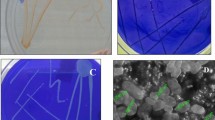Abstract
Ubiquinone-10 (CoQ10), a vitamin-like lipophilic component of the membrane-bound electron transport system, has a wide range of therapeutic, neutraceutical, and cosmeceutical applications. The objective of this study was to optimize nutritional requirements for production of CoQ10 by Paracoccus dinitrificans NRRL B-3785 fermentation. Effect of type and concentration of carbon and nitrogen source on fermentation kinetic parameters were analyzed using logistic and Luedeking-Piret equations. In submerged batch fermentation, yield of CoQ10 was 12.22 mg/L when 40 g/L glycerol was used and specific growth rate (0.056/h) as well as growth associated constant (α=0.680 mg/g) were higher as compared to other concentrations. Ammonium nitrate and proteose peptone at 5 (α=0.677 mg/g; β= 0.0072 mg/g·h) and 20 g/L (α=0.806 mg/g; β=0.0074 mg/g·h), respectively, were optimal for CoQ10 production. CoQ10 formation observed to be both growth and nongrowth associated. In optimized medium CoQ10 formation increased considerably from 1.91 to 14.12 mg/L.
Similar content being viewed by others
References
Lenaz G, Fato R, Formiggini G, Genova ML. The role of coenzyme Q in mitochondrial electron transport. Mitochondrion 7(suppl. 1): S8–S33 (2007)
Klingen AR, Palsdottir H, Hunte C, Ullmann GM. Redox-linked protonation state changes in cytochrome bc1 identified by Poisson-Boltzmann electrostatics calculations. Biochim. Biophys. Acta 1767: 204–221 (2007)
Mitchell P. The vital protonmotive role of coenzyme Q. Vol. 6, pp. 3–10. In: Biomedical and Clinical Aspects of Coenzyme Q. Folkers K, Littarru GP, Yamagami T (eds). Elsevier, Amsterdam, Netherlands (1991)
Sarter B. Coenzyme Q10 and cardiovascular disease: A review. J. Cardiovasc. Nurs. 16: 9–20 (2002)
Gaby AR. The role of coenzyme Q10 in clinical medicine: Part I. Altern. Med. Rev. 1: 11–17 (1996)
Sharma S, Kheradpezhou M, Shavali S, Refaey HE, Eken J, Hagen C, Ebadi M. Neuroprotective actions of coenzyme Q10 in Parkinson’s disease in Section IV-Quinones and age related diseases. Method. Enzymol. 382: 488–510 (2004)
Beal MF. Coenzyme Q10 as a possible treatment for neurodegenerative diseases. Free Radical Res. 36: 455–460 (2002)
Folkers K, Langsjoen P, Willis R, Richardson P, Xia LJ, Ye CQ, Tamagawa H. Lovastatin decreases coenzyme Q levels in humans. P. Natl. Acad. Sci. USA 87: 8931–8934 (1990)
Geromel V, Darin N, Chretien D, Benit P, DeLonlay P, Rotig A, Munnich A, Rustin P. Coenzyme Q(10) and idebenone in the therapy of respiratory chain diseases: Rationale and comparative benefits. Mol. Genet. Metab. 77: 21–30 (2002)
Lockwood K, Moesgaard S, Folkers K. Partial and complete regression of breast cancer in patients in relation to dosage of coenzyme Q10. Biochem. Bioph. Res. Co. 199: 1504–1508 (1994)
Tarnopolsky MA, Beal MF. Potential for creatine and other therapies targeting cellular energy dysfunction in neurological disorders. Ann. Neurol. 49: 561–574 (2001)
Rona C, Vailati F, Berardesca E. The cosmetic treatment of wrinkles. J. Cosmet. Dermatol. 3: 26–34 (2004)
Sakaki K, Watanabe M, Suda Y, Ishizuka A, Noparatnaraporn N. Applications of photosynthetic bacteria for medical field. J. Biosci. Bioeng. 100: 481–488 (2005)
Negishi ES, Liou Y, Xu C, Huo A. A novel, highly selective, and general methodology for the synthesis of 1,5-diene-containing oligoisoprenoids of all possible geometrical combinations exemplified by an iterative and convergent synthesis of coenzyme Q10. Org. Lett. 4: 261–264 (2002)
Lipshutz BH, Mollard P, Pfeiffer SS, Chrisman W. A short, highly efficient synthesis of coenzyme Q10. J. Am. Chem. Soc. 124: 14282–14283 (2002)
Folkers KA, Woodruff HB. Fermentation production of coenzyme-Q10. US Patent 3,066,080 (1962)
Yoshida H, Kotani Y, Ochiai K, Araki K. Production of CoQ10 using bacteria. J. Gen. Appl. Microbiol. 44: 19–26 (1998)
Peter K, Zgor K, Vladimir D. Effect of oxygen on CoQ10 production by Paracoccus denitrificans. Biotechnol. Lett. 15: 1001–1002 (1993)
Yen HW, Chiu CH. The influences of aerobic-dark and anaerobiclight cultivation on CoQ10 production by Rhodobacter sphaeroides in the submerged fermenter. Enzyme Microb. Tech. 41: 600–604 (2007)
Park YC, Kim SJ, Choi JH, Lee WH, Park KM, Kawamukai M, Ryu YW, Seo JH. Batch and fed-batch production of coenzyme Q10 in recombinant Escherichia coli containing the decaprenyl diphosphate synthase gene from Gluconobacter suboxydans. Appl. Microbiol. Biot. 67: 192–196 (2005)
Bule MV, Singhal RS. Use of carrot juice and tomato juice as natural precursors for enhanced production of ubiquinone-10 by Pseudomonas diminuta NCIM 2865. Food Chem. 116: 302–305 (2009)
Gu SB, Yao JM, Yuan QP, Xue PJ, Zheng ZM, Yu ZL. Kinetics of Agrobacterium tumefaciens ubiquinone-10 batch production. Process Biochem. 41: 1908–1912 (2006)
Lee JK, Her G, Kim SY, Seo JH. Cloning and functional expression of the dps gene encoding decaprenyl diphosphate synthase from Agrobacterium tumefaciens. Biotechnol. Progr. 20: 51–56 (2004)
Bok SH, Demain AL. An improved colorimetric assay for polyols. Anal. Biochem. 81: 21–27 (1977)
Ashby RD, Solaiman DKY, Foglia TA. Bacterial poly(hydroxyalkanoate) polymer production from the biodiesel co-product stream. J. Polym. Environ. 12: 105–112 (2004)
Meganathan R. Ubiquinone biosynthesis in microorganisms. FEMS Microbiol. Lett. 203: 131–139 (2001)
Matsumura M, Kobayashi T, Aiba S. Anaerobic production of ubiquinone-10 by Paracoccus dinitrificans. Eur. J. Appl. Microbiol. 17: 85–89 (1983)
Ashby RD, Solaiman DKY, Foglia TA. Synthesis of short-/mediumchain-length poly (hydroxyalkanoate) blends by mixed culture fermentation of glycerol. Biomacromolecules 6: 2106–2112 (2005)
Author information
Authors and Affiliations
Corresponding author
Rights and permissions
About this article
Cite this article
Bule, M.V., Singhal, R.S. Fermentation kinetics of production of ubiquinone-10 by Paracoccus dinitrificans NRRL B-3785: Effect of type and concentration of carbon and nitrogen sources. Food Sci Biotechnol 20, 607–613 (2011). https://doi.org/10.1007/s10068-011-0086-6
Received:
Revised:
Accepted:
Published:
Issue Date:
DOI: https://doi.org/10.1007/s10068-011-0086-6




